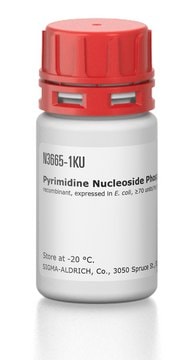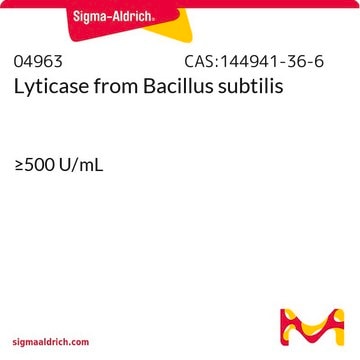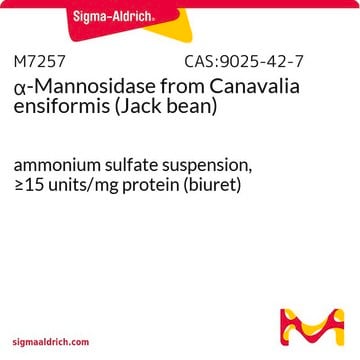SRE0006
Thymidine Phosphorylase, recombinant from Escherichia coli
recombinant, expressed in E. coli, Suitable for manufacturing of diagnostic kits and reagents, buffered aqueous solution, ≥500 units/mL
Sinonimo/i:
Gliostatins, PD-ECGF, Thymidine:orthophosphate deoxy-D-ribosyltransferase
About This Item
Prodotti consigliati
Ricombinante
expressed in E. coli
Livello qualitativo
Forma fisica
buffered aqueous solution
Concentrazione
≥500 units/mL
tecniche
inhibition assay: suitable
Colore
colorless to yellow
Solubilità
soluble
water: soluble
N° accesso NCBI
N° accesso UniProt
applicazioni
diagnostic assay manufacturing
Condizioni di spedizione
wet ice
Temperatura di conservazione
2-8°C
Informazioni sul gene
Escherichia coli ... deoA(948901)
Cerchi prodotti simili? Visita Guida al confronto tra prodotti
Descrizione generale
The E. coli thymidine phosphorylase shares 40% sequence homology with the human sequence, which is identical to the angiogenic agent platelet-derived endothelial growth factor. The purified E. coli enzyme has been shown to stimulate blood vessel growth in chick chorioallantoic membrane assays.
Applicazioni
- in a study to evaluate biomarkers for advanced breast cancer patients treated with capecitabine-based first-line chemotherapy.
- in a study to investigate implications for the clinical efficacy of nucleoside analogues.
Azioni biochim/fisiol
Definizione di unità
Nota sulla preparazione
Codice della classe di stoccaggio
12 - Non Combustible Liquids
Classe di pericolosità dell'acqua (WGK)
WGK 2
Punto d’infiammabilità (°F)
Not applicable
Punto d’infiammabilità (°C)
Not applicable
Certificati d'analisi (COA)
Cerca il Certificati d'analisi (COA) digitando il numero di lotto/batch corrispondente. I numeri di lotto o di batch sono stampati sull'etichetta dei prodotti dopo la parola ‘Lotto’ o ‘Batch’.
Possiedi già questo prodotto?
I documenti relativi ai prodotti acquistati recentemente sono disponibili nell’Archivio dei documenti.
Il team dei nostri ricercatori vanta grande esperienza in tutte le aree della ricerca quali Life Science, scienza dei materiali, sintesi chimica, cromatografia, discipline analitiche, ecc..
Contatta l'Assistenza Tecnica.





